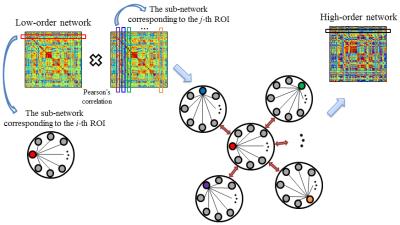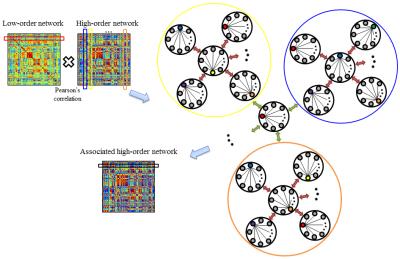1694
Hybrid high-order resting-state functional connectivity networks for mild cognitive impairment diagnosis1Biomedical Research Imaging Center, University of North Carolina at Chapel Hill, Chapel Hill, NC, United States
Synopsis
This study proposes a novel approach named “hybrid high-order FC networks” to explore the higher-level interactions among brain regions for improving the diagnosis performance of early mild cognitive impairment. We first construct the low-order network and the topographical similarity-based high-order network. With the two-level FC networks, we propose to construct a new “associated high-order network”, which is formed by estimating the higher-level interactions between the high-order sub-networks and low-order sub-networks. We further devise a multi-kernel learning strategy to integrate the dynamic networks of the three different levels. A high diagnosis accuracy of 91.5 % demonstrates effectiveness of our proposed approach.
Introduction
Functional connectivity (FC) estimated from resting-state functional magnetic resonance imaging (rs-fMRI) has been increasingly applied to investigate normal and aberrant brain function1. Conventional low-order FC network estimates the correlations of the rs-fMRI time series among different brain regions, simply ignoring the potentially complex relationships in the brain network2,3. Previously, we proposed a high-order FC calculation methods based on topographical similarity, which alleviated the problem and has proven to be effective for abnormality detection of brain disease3,4. However, the separate construction of low-order and high-order FC networks overlooks an intriguing relationship between the two-levels of FCs, where inter-level information exchange may occur. Such information exchange could be essential for understanding the complex infrastructure of brain functional networks and more sensitive to disease-induced changes in its early stage. In this study, we propose a novel approach named “hybrid high-order FC networks” and aim to explore the higher-level interactions among brain regions for improving the diagnosis performance of early mild cognitive impairment (eMCI).Methods
In the proposed framework, FC is computed using Pearson’s correlation. We adopt sliding window strategy to segment the entire rs-fMRI time series into multiple sub-series. For each of them, we first construct the traditional low-order network and the topographical similarity-based high-order network (see Figure 1). With the two-level FC networks, we propose to construct a new high-order network, named “associated high-order network”, which is formed by estimating the higher-level interactions between the high-order sub-networks and low-order sub-networks (see Figure 2). To integrate the dynamic networks of the three different levels, we further devise a multi-kernel learning strategy. These constructed dynamic FC networks are transformed into frequency domain for discriminant feature extraction and selection. Support vector machine (SVM)-based multi-kernel learning is then implemented to fuse complementary features from the dynamic low-order, high-order and associated high-order networks for brain disease diagnosis.Results
Experimental study is implemented on 29 eMCI subjects (13F/16M) and 30 normal control subjects (17F/13M) selected from ADNI 2 dataset5. The diagnosis performance is evaluated by the metrics including classification accuracy (ACC), area under ROC curve (AUC), Sensitivity (SEN) and Specificity (SPE). The results (see Table 1) based on leave-one-out cross-validation indicate that high-order networks obviously enhance the classification performance in comparison with low-order networks. More importantly, the integration of low-order, high-order and associated high-order networks with multi-kernel learning yields the best performance with a classification accuracy of 91.5%.Discussion and Conclusion
The newly proposed associated high-order FC network has proven to be able to reveal higher-level interactions among different pairs of brain regions, thereby resulting in an improved diagnosis performance. By multi-kernel learning, we found that the low-order, high-order and associated high-order FC networks contribute to the classification accuracy in vary degrees, and provide complementary discriminant features. The proposed framework of hybrid high-order networks provides an effective way to fuse the features from the three types of FC networks for further boosting the diagnosis accuracy. The experimental results demonstrate that the novel approach is a promising tool for eMCI diagnosis.Acknowledgements
This work was supported in part by NIH grants EB006733, EB008374, EB009634, MH100217, AG041721 and AG042599.References
1. Smith SM, et al. Functional connectomics from resting-state fMRI. Trends Cogn. Sci., 2013, 17(12): 666-682.
2. Wee CY, et al. Sparse temporally dynamic resting-state functional connectivity networks for early MCI identification. Brain Imaging Behav. 2015, 10(2): 342-356.
3. Chen X, et al. High-order resting-state functional connectivity network for MCI classification. Hum. Brain Mapp. 2016, 37(9): 3282-3296.
4. Zhang H, et al. Topographical information-based high-order functional connectivity and its application in abnormality detection for mild cognitive impairment. J. Alzheimers Dis. 2016, 54(3): 1095-1112.
5. http://adni.loni.usc.edu/
Figures


